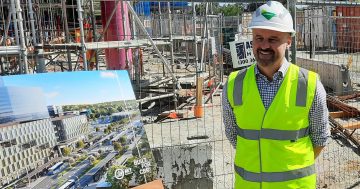
Chief Minister Andrew Barr lives in a 120 square metre home. Photo: Michelle Kroll.
Is a 120 sqm home big or small?
Chief Minister Andrew Barr seems to have got the town talking about this with his “That’s enormous!” comment in response to a question at the ACT Property Council’s recent lunch where he gave the keynote speech.
Mr Barr, who lives in a 120 sqm home himself, was defending the size limit imposed on dual occupancy developments in RZ1 zones.
He tends to hyperbole when making a point, but the Chief Minister’s response that a 120sqm home was bigger than most two and three-bedroom townhouses was correct.
My partner and I have downsized to a two-bedroom townhouse that we find surprisingly spacious and adequate for our needs and it is just over the 100 sqm mark.
Planning Minister Mick Gentleman also chimed in during the week, retelling his now familiar tale to journalists of his children growing up in a 120 sqm home and more than surviving the experience.
Having lived in standalone homes of varying sizes with a backyard all my life, first as a child growing up and then raising a family of my own, the notion that anything else would be too confining was hard to shake.
I still rue the decline of the backyard and the implications for families and children, so I have some sympathy with calls for more detached homes to be built, but Mr Barr was talking about increasing the overall diversity of housing stock in Canberra to meet the needs of people in different phases of their life.
The other factors driving greater density are the sheer overwhelming cost of housing these days, not enough homes to meet demand, the need to contain the city within a manageable footprint and the fact that many people want to live closer to the city and near services.
Offering a smaller and hopefully more affordable home in an established suburb makes sense.
And there are good reasons to limit dual occupancies to properties greater than 800 sqm while restricting the size to 120 sqm because the fear is that Canberra’s garden city values will be swamped by brick and tile.
There should still be sufficient space for a garden and shade trees to meet the living infrastructure goals, prevent the urban heat effect that unrestrained densification would bring and maintain or enhance a neighbourhood.
Far from being shoeboxes, 120 squares should be plenty to play with if good design principles are employed to be economic with space.
Architects will tell you that poor design wastes space and chews up land that could be used for greenery.
But Mr Barr is not talking about cramming families into smaller homes, although I’m sure some with one or two small children would manage nicely.
He sees them as mainly options for young people and downsizers, especially those who want to age in place on a single level.
These, along with apartments and townhouses, should free up bigger properties for growing families.
Canberra really has no choice but to increase the supply and type of homes available to meet its growing population and put the housing that people need within reach, either to be purchased or rented.
The 120 sqm home on a divided block is one important part of the equation but far from the only one.
It should not be seen in isolation or denigrated as some sort of ‘granny flat’.
If it’s good enough for the Chief Minister …





















